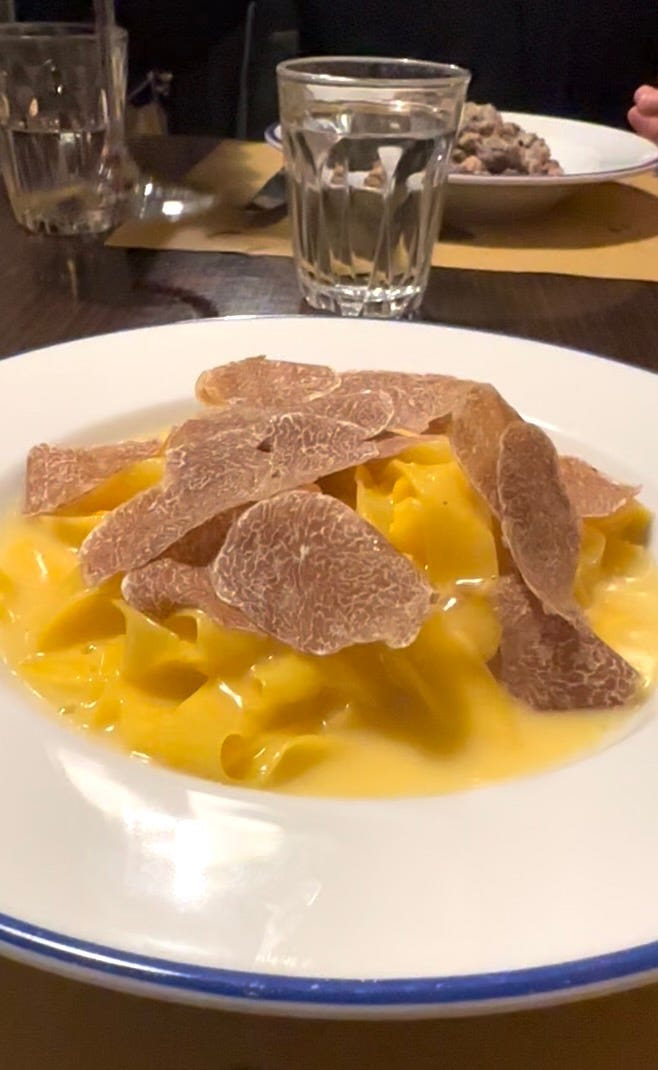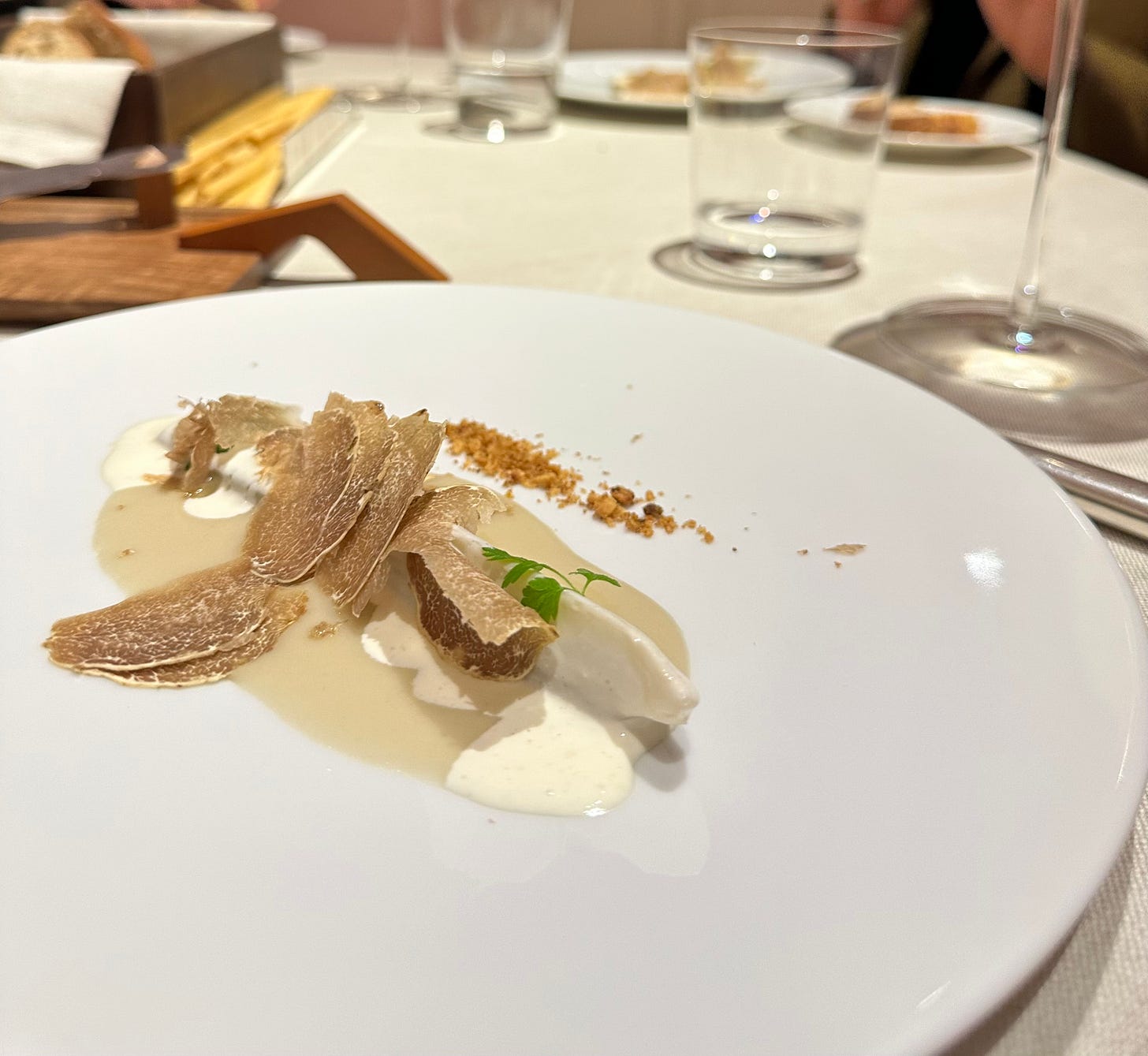November 29th (in)composition: Piedmont
the rare white fungus, folding screens at the fondazione prada and plump cherubs of Guarene
what’s in season: tartufi bianco d’alba
As you might expect, Italians don’t celebrate Thanksgiving, but that doesn’t mean you can’t properly celebrate this American tradition in Italy. This year, that’s what I did, trading turkey1 for tartufi.
My pilgrimage to Piedmont, also home of Barolo and Barbera wines, was an unparalleled experience, both humbling and decadent. Nestled into the gentle slopes of Piedmont is the rare jewel that grows wild during the Fall and early Winter months: the tartufo bianco. One of the most coveted mushrooms on earth, they are worthy of their reputation.
The white truffle’s scientific name is “tuber magnatum pico”. These truffles are a wild fungus that can only grow underground, in moist soil, at the roots of lindens, willows, oaks, and poplar trees. The truffles vary in color and size, displaying every shade of amber, grey and white. Some contain varying gorgeous marble-like pink veining, darker red fleshy spots, or even yellowing depending on their host tree.
My first stop was in Alba, world-renowned for the special quality of their truffles and where most white truffles are regionally and globally sourced.



“And all the time he wasn’t busy painting he spent with us, as one of the family. It was from this intimacy that an instinctive, hybrid work of art took shape where - in addition to some of Clemente’s recurrent motifs, such as lipsticks, the deer, the cage from which birds have escaped - we find echoes of our Langhe region, like the vine leaves.”
While Alba is known as the motherland of white truffles, my schooling occurred in Canelli. I had the pleasure of meeting a wonderful man named Michele, who had an even more wonderful hunting dog named Fulmine (aka Lightning). Their goal is to put their hometown on the map. Boasting that Canelli has some of the finest truffles in the world, I joined Michele and Fulmine on their rigorous hunt for their coveted white truffles.
Michele taught me the intricacies of the landscape necessary for truffle growth. He first pointed out the poplar trees on his land, the key breed for Canelli truffles. He then highlighted areas alongside streams and deeper crevices within the valleys. These are the areas that draw the most moisture, allowing for perfect truffle growing conditions. Unfortunately, rain has been less frequent in the falls than in previous years as a result of climate change, making for later and less abundant truffle seasons, but they’re still very much present.
Ultimately, we followed alongside our human and canine guide, cheering on our star hunting dog with words of encouragement: “Bravo!”, “Encore!”, “Andiamo!” as he zipped from one tree to the next . Keeping his spirits high over the course of the hunt was key to keeping his attention and focus. The truffles are often buried pretty deep underground. Fulmine starts with a deep nose sniff and quick dig before Michele joins in with a mini shovel. It was a grueling task and after a couple of hours, Fulmine had to retire back to the house, but not before pointing out a potential spot where they could possible get lucky the next day. Thankfully, we were able to taste a Canelli truffle from a prior hunt. Fulmine also had a nibble.
At every trattoria and osteria in Piedmont, we enjoyed tartufi on humble dishes. A simple buttered noodle, a bowl of gnocchi, a slice of buttered bread, a poached egg, or a subtly cooked vegetable were the best vehicles for the fleeting truffle.





what to see in Milan: paraventi, folding screens from the 17th to 21st centuries at the ondazione prada, milano
Curated by Nicholas Cullinan, the exhibition up at the Prada Foundation in Milano “traces the origins of paravents in China in the late Chou dynasty, where they began as objects of spiritual contemplation and inspiration; their migration to Japan, often placed at the threshold of a home to ward off malign influences; the way they were then imported to the West, in the process parsing the evolving distinction between polyptychs and paravents; their deployment during the Baroque period as props in both theater and opera; and finally and most fundamentally, their adoption by an astonishing array of artists, architects, and designers during the 19th and 20th centuries, and on to the present.”2
“Either/or, neither/nor: painting or sculpture? Art or furniture? Utilitarian or ornamental? Prop or performative device? Decorative, functional, architectural or theatrical?”
The exhibition is divided into segments expanding two floors.
“Readings, East and West”—focuses on how the decorations on the works can be read, whether from the right or left, as landscape or cartography, emphasizing their transnational character and complex history of migration and translation.
“Public/Private” explores the function of folding screens to create spaces for purposes of intimacy, with particular reference to their erotic nature and sexual connotation, from the domestic dimension to taboos.
“Split Screens” highlights how screens today reflect our pervasive digital experience. Originally, a folding screen was not a place of visibility, but an object offering physical protection. This dialectic between revelation and concealment survives today in the screens of our devices, which are both opaque and transparent, windows and flat surfaces.
“Four Seasons: Space and Time, Figuration and Abstraction” examines how screens’ physical structure allows the narrative to unfold sequentially in space and time, both in the traditional representation of the seasons and through figuration and abstraction.
“Propaganda,” artists reflect on screens’ political and provocative potential. Furniture and decoration are domains in which ‘high’ art is separated from art considered less pure.
“World of Interiors” addresses the potential subversiveness of queer aesthetics to redefine the semantic field of what is considered decorative.
“Parody/Paradox” section, we analyze transparent screens, works whose structure contradicts the screening function, with humorous or parodical effects. - 3
Francis Bacon “set up his own business as an interior designer, creating from 1928–30 carpets, tables, chairs, and of course Painted Screen. The trigger for it was apparently Bacon’s encounter with Art Déco in Paris and especially the influence of Eileen Gray, whose showroom, the Galerie Jean Désert, Bacon came across in 1928 at the age of eighteen. By the next year, and around the time this screen was made in London, Bacon opened his own design studio at 17 Queensberry Mews, with business cards that read: “Francis Bacon – Modern Decoration, Furniture in Metal, Glass and Wood/Rugs and Lights.” Compare this pride to his later shame about his decorative origins: “He never mentioned” them, Bacon’s biographer Michael Peppiatt explains. “Decoration was one of the foulest words in his vocabulary after that.” Indeed, this work remained unseen during Bacon’s lifetime, and was only publicly exhibited in 1993, and later on Bacon would describe his painting practice as “clearing away the screens” that obstruct our perception of raw sensation.”

Carrie Mae Weems recounts the biblical story of Adam and Eve, gender roles and differences, and the unequal power that comes with them. Here a silkscreen image of what appears to be a naked woman save from a shroud (and don’t the shroud and the veil have something in common with the screen?) is the central panel of the triptych. There is sexual tension in the simultaneous shielding and revealing of the central figure, as Weems acknowledges: “There is great desire, seduction, sexual charge,” and “Both men and women are accomplices in their own downfall, in their own oppression, in their own victimization.”
Screen 4 is one of several screens in which Lorna Simpson accompanies black-and-white photographic images with a text to form a narrative. As Bonita McLaughlin writes: “Simpson calls attention to the emphasis on sexuality so often found in representations of black women by simply omitting it. Standing with arms crossed, or at her sides, or on her hips, and wearing the ubiquitous white shift, here baggy and wrinkled, Simpson’s model chooses neither to please nor attract. The gap between her reality and the desire for pleasure inherent in the male gaze is also alluded to in the words inscribed on one of the panels: ‘She was no more exotic than the sparse room she posed in’.”
Marlene Dumas’ screen is representative of the intense emotional content of her figurative paintings at the time. Bold, expressive brush strokes make up eight nude figures on either side of the four-panel screen. Perhaps at first glance genderless, the figures on one side of the screen are depicted with male organs, the other female in an evocation of the themes strongly present in Dumas’s work related to identity, sexuality, desire, and the complexities of the human experience.
Parody is another strategy to question the unsettled status of folding screens. Mona takes wordplay and an almost Surrealist displacement of an object by creating an oversize, human-scale cheese grater, that here morphs this commonplace kitchen utensil into a freestanding folding screen to create something humorous yet menacing.

Bent steel and perforated aluminum. As of 1924, Prouvé began producing modern furniture in metal and wood with leading designers, including Le Corbusier and Charlotte Perriand. Inspired by the linear aesthetics of airplanes, he developed a style based on clean, streamlined forms and produced his experimental designs in aluminum and steel. Believing in the political and social power of design, he worked enthusiastically on the development of prefabricated products. In 1947 Prouvé opened a factory in Maxéville that specialized in prefabricated buildings and furniture based on the use of folded or stamped metal sheets. This soundproofed panel board was designed for the Centre national d’enseignement technique de Cachan in 1955.
Cy Twombly’s Paravent has never been exhibited, is decorated with the same peony motif of Edo-period screens, and is important in being an influence on his ten later Untitled paintings from 2006–07. The main theme of works like this is Japonisme, and it features prominently the 17th-century haiku poetry of Basho. John Cage also had a keen interest in Zen Buddhism and Haiku, and in Fall 1951 he and Twombly attended lectures on these subjects by the Japanese philosopher Daisetz T. Suzuki at Columbia University in New York.


Aram’s monumental screen draws upon two sets of seemingly divergent cultural references, in this case the tessellated patterns of Iranian architecture and decoration, and Natalia Goncharova’s Spring (1927/28), a painting of similar dimensions.
design crush at the castello: the hand painted cherubs at castello di guarene
If you would like my Piedmont itinerary, ask!
XX,
D
which as a vegetarian I consistently do #BVE
https://www.fondazioneprada.org/wp-content/uploads/Leaflet_Paraventi_ENG.pdf
https://www.fondazioneprada.org/wp-content/uploads/Leaflet_Paraventi_ENG.pdf




















